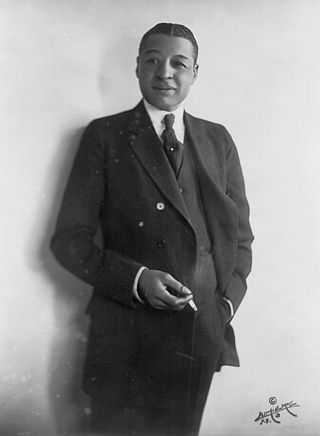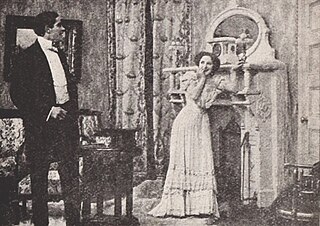
Mack Sennett was a Canadian-American producer, director, actor, and studio head who was known as the "King of Comedy" during his career.

Gottfried Wilhelm Bitzer was an American cinematographer, notable for his close association and pioneering work with D. W. Griffith.

Bert Williams was a Bahamian-born American entertainer, one of the pre-eminent entertainers of the vaudeville era and one of the most popular comedians for all audiences of his time. While some sources have credited him as being the first Black man to have a leading role in a film with Darktown Jubilee in 1914, other sources have credited actor Sam Lucas with this same distinction for a different 1914 film, the World Film Company's Uncle Tom's Cabin. Ebony stated that "Darktown Follies was the first attempt of an independent film company to star a black actor in a movie", and credited the work as beginning a period in independent American cinema that explored "black themes" within works made for African-American audiences by independent producers.

Biograph Studios was an early film studio and laboratory complex, built in 1912 by the Biograph Company at 807 East 175th Street, in The Bronx, New York City, New York, which was preceded by two locations in Manhattan.

The Biograph Company, also known as the American Mutoscope and Biograph Company, was a motion picture company founded in 1895 and active until 1916. It was the first company in the United States devoted entirely to film production and exhibition, and for two decades was one of the most prolific, releasing over 3000 short films and 12 feature films. During the height of silent film as a medium, Biograph was the most prominent U.S. film studio and one of the most respected and influential studios worldwide, only rivaled by Germany's UFA, Sweden's Svensk Filmindustri and France's Pathé. The company was home to pioneering director D. W. Griffith and such actors as Mary Pickford, Lillian Gish, and Lionel Barrymore.

The Golden Louis is a 1909 American drama film written by Edward Acker, directed by D. W. Griffith, and produced by the Biograph Company in New York City. Originally, this short was distributed to theaters on a "split reel", accompanying another Griffith-directed film, the comedy The Politician's Love Story.

Thomas Hayes Hunter was an American film director and producer of the silent era. He directed a total of 34 films between 1912 and 1934.
Richard Smith, also known as Dick Smith, was a screenwriter, actor, and film director. Smith was born in Cleveland, Ohio, and became a comedian active in the vaudeville era. He met his wife Alice Howell in 1910 and the two performed together as Howell and Howell. After working under direction of Mack Sennett at the American Mutoscope and Biograph Company in New York City, Smith moved to Los Angeles, California. Smith and his wife starred in reels together produced by L-KO Kompany.

The Lost Bridegroom a 1916 American silent comedy film produced by Adolph Zukor starring John Barrymore. Appearing alongside Barrymore in this film is his first wife Katherine Corri Harris. It was based on the short story titled "The Man Who Was Lost" by Willard Mack with James Kirkwood as its director. The film had the alternative title His Lost Self and was rereleased by Paramount on April 17, 1919 as part of their "Success Series", a celebration of some of the company's early screen triumphs. Though it obviously still existed by 1919, it is a lost silent film today.

The Maniac Cook is a 1909 American silent thriller film produced by the Biograph Company of New York, directed by D. W. Griffith, and starring Anita Hendrie in the title role. Principal cast members also include Harry Solter and Marion Leonard.

Edgar Allen Poe [sic] is a 1909 American silent drama film produced by the Biograph Company of New York and directed and co-written by D. W. Griffith. Herbert Yost stars in this short as the 19th-century American writer and poet Edgar Allan Poe, while Linda Arvidson portrays Poe's wife Virginia. When it was released in February 1909 and throughout its theatrical run, the film was consistently identified and advertised with Poe's middle name misspelled in its official title, using an "e" instead of the correct second "a". The short was also originally shipped to theaters on a "split reel", which was a single reel that accommodated more than one film. This 450-foot drama shared its reel with another Biograph short, the 558-foot comedy A Wreath in Time. Prints of both films survive.

A Wreath in Time is a 1909 American silent comedy film written and directed by D. W. Griffith, produced by the Biograph Company of New York City, and co-starring Mack Sennett and Florence Lawrence. At its release in February 1909, the short was distributed to theaters on a "split reel", which was a single reel that accommodated more than one film. A Wreath in Time shared its reel with another Biograph short also directed by Griffith, the drama Edgar Allen Poe [sic]. Original paper rolls of contact prints of both motion pictures, as well as safety-stock copies of the two films, are preserved in the Library of Congress.

Lime Kiln Field Day is a 1913 American black-and-white silent film produced by the Biograph Company and Klaw and Erlanger. Unnamed, unassembled, and abandoned by its producers during post-production, the original footage was saved when Biograph donated its vaults to the Museum of Modern Art in 1938. It is considered to be the oldest surviving feature film with an all-Black cast.

The Heiress at Coffee Dan's is a 1916 American silent comedy-drama film produced by the Fine Arts Film Company and distributed by Triangle Film Corporation. It starred Bessie Love and was directed by Edward Dillon.
The Passing of Wolf MacLean is a 1924 silent Western film directed by Paul Hurst and produced by and starring Jack Mower.

Trying to Get Arrested is a 1909 American comedy short film directed by D. W. Griffith, produced by the Biograph Company of New York City, and starring John R. Cumpson. Filmed in two days in early 1909 at Palisades Park, New Jersey, it was released in April that year and distributed to theaters on a "split reel", which was a single film reel that included more than one motion picture. The other picture that accompanied this comedy was the Biograph "dramedy" The Road to the Heart.

A Rude Hostess is a 1909 American silent film comedy written and directed by D. W. Griffith, produced by the American Mutoscope and Biograph Company in New York City, and co-starring Marion Leonard and Arthur V. Johnson. At its release in April 1909, the short was distributed to theaters on a "split reel", which was a single reel that accommodated more than one film. A Rude Hostess shared its reel with another Biograph comedy short directed by Griffith, Schneider's Anti-Noise Crusade. Original contact-print paper rolls of both motion pictures, as well as projectable safety-stock copies of the films, are preserved in the Library of Congress.

Jones and His New Neighbors is a 1909 American silent comedy film written by Frank E. Woods and directed by D. W. Griffith. Produced by the American Mutoscope and Biograph Company in New York City, the short stars John R. Cumpson, Florence Lawrence, and Anita Hendrie. It is one film in a series of 1908 and 1909 Biograph pictures in which Cumpson and Lawrence performed together as the married couple Mr. and Mrs. Jones. When this comedy was released in March 1909, it was distributed to theaters on a "split reel", which was a single projection reel that accommodated more than one motion picture. It shared its reel with another Biograph short directed by Griffith, the dramatic "thriller" The Medicine Bottle.

The Invisible Fluid is a 1908 American silent science fiction comedy film produced by the American Mutoscope and Biograph Company of New York, directed by Wallace McCutcheon Sr., and starring Edward Dillon. The short's plot relies extensively on the filming and editing technique of substitution splicing, also known as "stop trick", a special effect that creates the illusion of various characters or objects suddenly vanishing on screen.

Chocolate Dynamite is a lost 1914 American silent comedy film produced by the Biograph Company and according to some modern references, directed by either Lionel Barrymore or Edward Dillon. Little is known about many aspects of this short, which had an approximate running time between six and seven minutes. No Biograph studio records have been found that conclusively identify its director or mention by name a single actor in the production. Records do document that the motion picture was based on "Captured by Dynamite", a short story written by Helen Combes. They also document that the comedy was filmed in New York City and was actually completed in late August 1913, a full six months before the company officially released it to theaters. During the picture's initial distribution in the United States, it was shipped on a "split reel", a term used in the silent era to describe a reel that held more than one motion picture. The film reel for Chocolate Dynamite also included Because of a Hat, another Biograph comedy short.


















